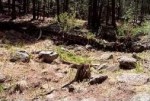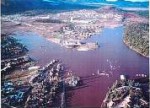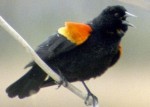Summary
The Rio de Flag exhibits the normal character of many streams. It originates in a spring, and the stream drops in elevation near the headwaters relatively quickly in comparison to the channel farther downstream. The vegetation and animals vary along the river in accordance with ecological conditions prevalent in the surrounding land, but with particular attraction of riparian species in the immediate vicinity of the channel.
 Ponderosa pine forest covers the south facing slope of the San Francisco Peaks where the springs occur. There is an open meadow at Baderville on the south side of US 180 where the land is lower and flatter. A steep and shallow canyon in the basalt lava flow occurs in the vicinity of the Museum of Northern Arizona with thick willows in and around the channel. In occasional ponds along the length of the river, bullrushes and cattails provide habitat for numerous aquatic animals. Northeast of Flagstaff, on its way to the Little Colorado, there is open scrubland. Ponderosa pine forest covers the south facing slope of the San Francisco Peaks where the springs occur. There is an open meadow at Baderville on the south side of US 180 where the land is lower and flatter. A steep and shallow canyon in the basalt lava flow occurs in the vicinity of the Museum of Northern Arizona with thick willows in and around the channel. In occasional ponds along the length of the river, bullrushes and cattails provide habitat for numerous aquatic animals. Northeast of Flagstaff, on its way to the Little Colorado, there is open scrubland.
 A riparian environment in the arid southwest always adds diversity of habitat and organisms to the landscape. The channel also serves as a wildlife corridor for some species of mammals and birds, e.g., hummingbirds and flycatchers. Where seeps emerge from cracks in the limestone, there are plants characteristic of moist conditions, e.g., the blue iris. A riparian environment in the arid southwest always adds diversity of habitat and organisms to the landscape. The channel also serves as a wildlife corridor for some species of mammals and birds, e.g., hummingbirds and flycatchers. Where seeps emerge from cracks in the limestone, there are plants characteristic of moist conditions, e.g., the blue iris.
When the pioneers first arrived in the Flagstaff area, the landscape around the San Francisco Peaks was a vast ponderosa pine forest interspersed with open parks. Bighorn sheep and Merriam elk roamed the forested hills. Pronghorn antelope were found in the park areas. Now, both the sheep and elk have disappeared, and the antelope seldom are seen near the Rio although they are present in the wilder areas around Flagstaff. Abert squirrels are still active where the pine forest reaches the edge of the stream. Many changes in species have occurred in Flagstaff.
 The Rio de Flag is one more example of a natural area heavily impacted by human activity. The springs are boxed (link above to the larger picture of Little Leroux Spring) and the water diverted. The beauty of the natural river is preempted for housing development. The channel has been rerouted and the occasional high volume flows blocked by culverts too narrow for the rare but inevitable large discharges, with sometimes disasterous effects. Far fewer wild species are found along the stream. The Rio de Flag is one more example of a natural area heavily impacted by human activity. The springs are boxed (link above to the larger picture of Little Leroux Spring) and the water diverted. The beauty of the natural river is preempted for housing development. The channel has been rerouted and the occasional high volume flows blocked by culverts too narrow for the rare but inevitable large discharges, with sometimes disasterous effects. Far fewer wild species are found along the stream.
 Nevertheless, the Rio still serves as a source of renewal and pleasure for many people. The Flagstaff Urban Trail System (FUTS) along its side provides both pedestrians and bicyclists an escape from the byproducts of the internal combustion engine. City Pond's peaceful waters ring with the happy sound of redwing blackbirds and kids picnicing and trying to fish. The diverted channel at Wheeler Park provides opportunities for rest and leisure. The trail through Sinclair Wash offers a chance for recreation and education. Nevertheless, the Rio still serves as a source of renewal and pleasure for many people. The Flagstaff Urban Trail System (FUTS) along its side provides both pedestrians and bicyclists an escape from the byproducts of the internal combustion engine. City Pond's peaceful waters ring with the happy sound of redwing blackbirds and kids picnicing and trying to fish. The diverted channel at Wheeler Park provides opportunities for rest and leisure. The trail through Sinclair Wash offers a chance for recreation and education.
| 



